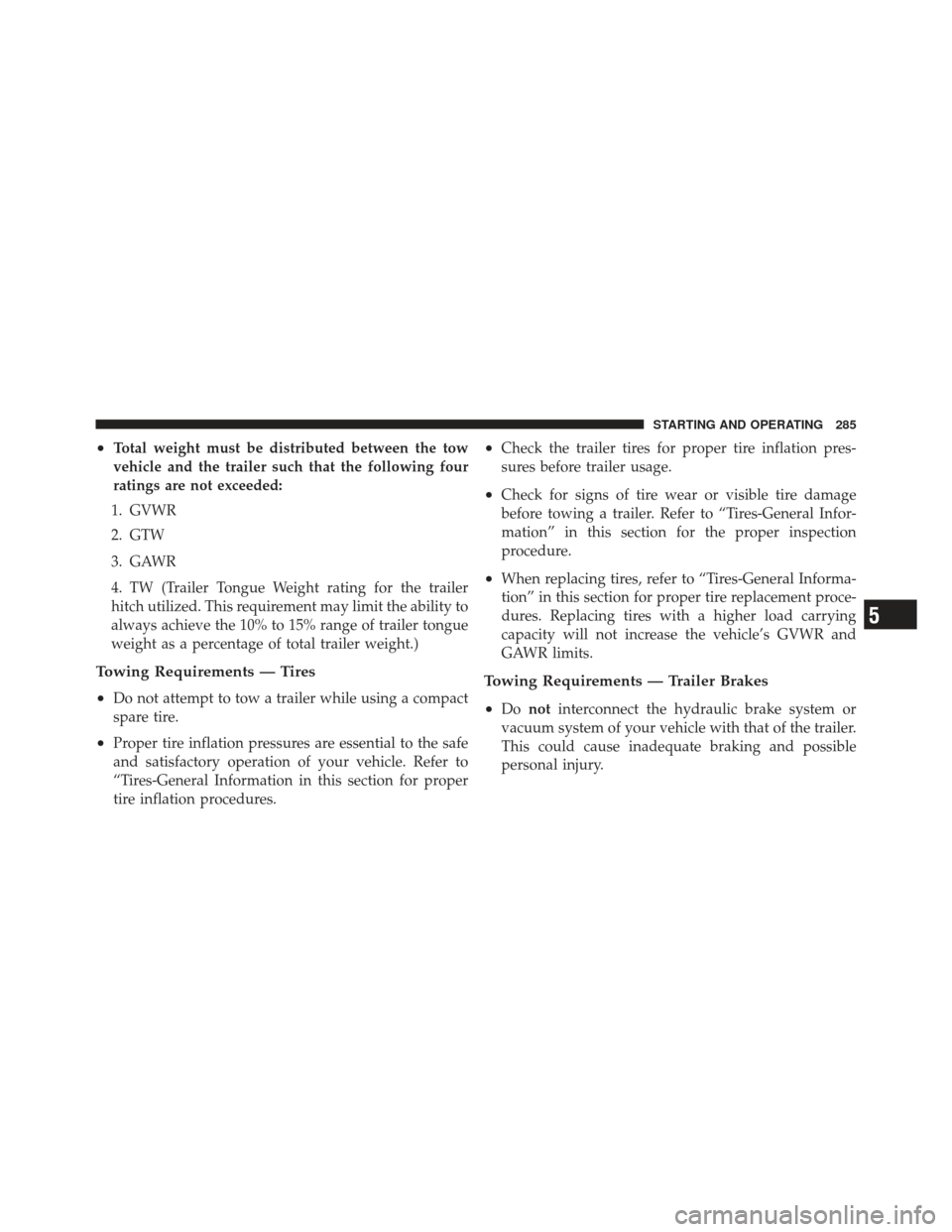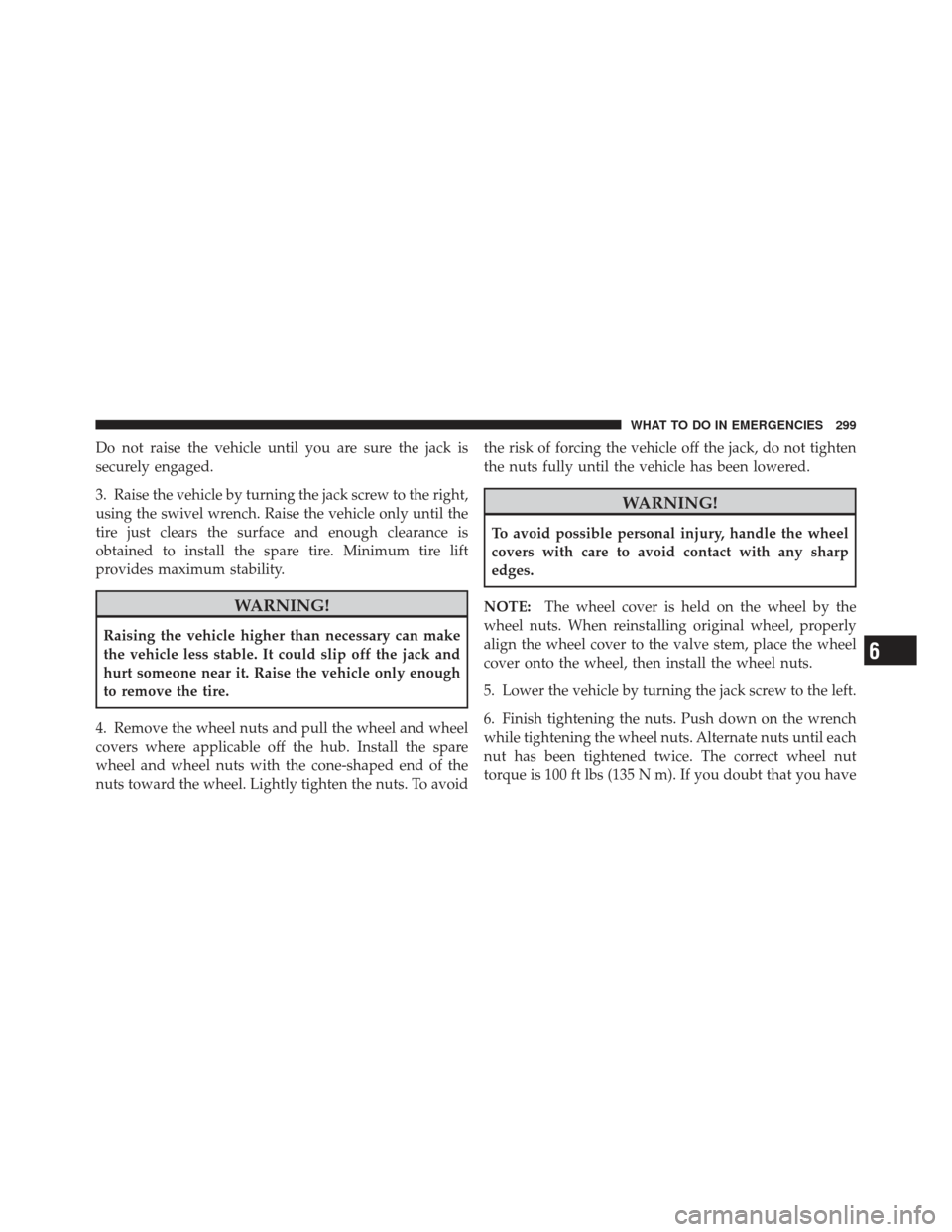Page 271 of 410

NOTE:
1. The compact spare tire (if equipped) does not have a
TPMS Sensor. Therefore, the TPMS will not monitor the
pressure in the compact spare tire.
2. If you install the compact spare tire in place of a road
tire that has a pressure below the low-pressure warning
limit, upon the next ignition key cycle, a chime will
sound and the TPMS Telltale Light will turn ON due to
the low tire.
3. After driving the vehicle for up to 20 minutes above
15 mph (25 km/h), the TPMS Telltale Light will flash on
and off for 75 seconds and then remain on solid.
4. For each subsequent ignition key cycle, a chime will
sound and the TPMS Telltale Light will flash on and off
for 75 seconds and then remain on solid.5. Once you repair or replace the original road tire, and
reinstall it on the vehicle in place of the compact spare,
the TPMS will update automatically and the TPMS
Telltale Light will turn OFF, as long no tire pressure is
below the low-pressure warning limit in any of the four
active road tires. The vehicle may need to be driven for
up to 20 minutes above 15 mph (25 km/h) in order for the
TPMS to receive this information.
General Information
This device complies with part 15 of the FCC rules and
RSS 210 of Industry Canada. Operation is subject to the
following conditions:
•This device may not cause harmful interference.
•This device must accept any interference received,
including interference that may cause undesired
operation.
5
STARTING AND OPERATING 269
Page 287 of 410

•Total weight must be distributed between the tow
vehicle and the trailer such that the following four
ratings are not exceeded:
1. GVWR
2. GTW
3. GAWR
4. TW (Trailer Tongue Weight rating for the trailer
hitch utilized. This requirement may limit the ability to
always achieve the 10% to 15% range of trailer tongue
weight as a percentage of total trailer weight.)
Towing Requirements — Tires
•
Do not attempt to tow a trailer while using a compact
spare tire.
•Proper tire inflation pressures are essential to the safe
and satisfactory operation of your vehicle. Refer to
“Tires-General Information in this section for proper
tire inflation procedures.
•Check the trailer tires for proper tire inflation pres-
sures before trailer usage.
•Check for signs of tire wear or visible tire damage
before towing a trailer. Refer to “Tires-General Infor-
mation” in this section for the proper inspection
procedure.
•When replacing tires, refer to “Tires-General Informa-
tion” in this section for proper tire replacement proce-
dures. Replacing tires with a higher load carrying
capacity will not increase the vehicle’s GVWR and
GAWR limits.
Towing Requirements — Trailer Brakes
•
Do not interconnect the hydraulic brake system or
vacuum system of your vehicle with that of the trailer.
This could cause inadequate braking and possible
personal injury.
5
STARTING AND OPERATING 285
Page 293 of 410
WHAT TO DO IN EMERGENCIES
CONTENTS
�Hazard Warning Flashers ................ 292
� If Your Engine Overheats ................ 292
� Jacking And Tire Changing ............... 294
▫ Jack Location ....................... 294
▫ Spare Tire Stowage ................... 295
▫ Spare Tire Removal ................... 295
▫ Preparations For Jacking ............... 296 ▫
Jacking Instructions ................... 296
� Jump-Starting Procedures ................ 300
� Freeing A Stuck Vehicle ................. 302
� Towing A Disabled Vehicle ............... 303
▫ Towing With The Key-In-Ignition ......... 303
▫ Towing Without The Key-In-Ignition ....... 304
6
Page 297 of 410
Spare Tire Stowage
The compact spare tire is stowed under the rear of the
vehicle by means of a hook/basket mechanism. To re-
move or stow the compact spare, use the jack handle to
rotate the “spare tire drive” nut. The nut is located under
the rear scuff plate at the right rear of the cargo area, just
inside the liftgate opening.
Spare Tire Removal
Lift up the cover and fit the jack-handle over the drive
nut. Rotate the nut to the left until you can remove the
swivel hook from the stowage basket. Swing the basket
down to remove the compact spare tire.
CAUTION!
The hook is designed for use with the jack handle
only. Use of an air wrench or other power tools is not
recommended and can damage the winch.
Spare Tire Storage
6
WHAT TO DO IN EMERGENCIES 295
Page 299 of 410
WARNING! (Continued)
•Always park on a firm, level surface as far from
the edge of the roadway as possible before raising
the vehicle.
•Block the wheel diagonally opposite the wheel to
be raised.
•Set the parking brake firmly, and shift a automatic
transmission into PARK; a manual transmission
into REVERSE.
•Never start or run the engine with the vehicle on a
jack.
•Do not let anyone sit in the vehicle when it is on a
jack.
•Do not get under the vehicle when it is on a jack.
•Only use the jack in the positions indicated and
for lifting this vehicle during a tire change.(Continued)
WARNING! (Continued)
•If working on or near a roadway, be extremely
careful of motor traffic.
•To assure that spare tires, flat or inflated, are
securely stowed, spares must be stowed with the
valve stem facing the ground.
•Turn on the Hazard Warning flasher.
1. Remove the scissors jack and lug wrench from the
stowage bag.
Jack Warning Label
6
WHAT TO DO IN EMERGENCIES 297
Page 301 of 410

Do not raise the vehicle until you are sure the jack is
securely engaged.
3. Raise the vehicle by turning the jack screw to the right,
using the swivel wrench. Raise the vehicle only until the
tire just clears the surface and enough clearance is
obtained to install the spare tire. Minimum tire lift
provides maximum stability.
WARNING!
Raising the vehicle higher than necessary can make
the vehicle less stable. It could slip off the jack and
hurt someone near it. Raise the vehicle only enough
to remove the tire.
4. Remove the wheel nuts and pull the wheel and wheel
covers where applicable off the hub. Install the spare
wheel and wheel nuts with the cone-shaped end of the
nuts toward the wheel. Lightly tighten the nuts. To avoid the risk of forcing the vehicle off the jack, do not tighten
the nuts fully until the vehicle has been lowered.
WARNING!
To avoid possible personal injury, handle the wheel
covers with care to avoid contact with any sharp
edges.
NOTE: The wheel cover is held on the wheel by the
wheel nuts. When reinstalling original wheel, properly
align the wheel cover to the valve stem, place the wheel
cover onto the wheel, then install the wheel nuts.
5. Lower the vehicle by turning the jack screw to the left.
6. Finish tightening the nuts. Push down on the wrench
while tightening the wheel nuts. Alternate nuts until each
nut has been tightened twice. The correct wheel nut
torque is 100 ft lbs (135 N m). If you doubt that you have
6
WHAT TO DO IN EMERGENCIES 299
Page 302 of 410

tightened the nuts correctly, have them checked with a
torque wrench by your authorized dealer or at a qualified
service station.
7. Remove the wheel blocks and lower the jack until it is
free. Stow the lug wrench, and jack in their designated
location. Secure all parts using the means provided.
WARNING!
A loose tire or jack thrown forward in a collision or
hard stop could endanger the occupants of the ve-
hicle. Always stow the jack parts and the spare tire in
the places provided. Have the deflated (flat) tire
repaired or replaced immediately.
8. Place the deflated (flat) tire in the cargo area, have the
tire repaired or replaced as soon as possible.
9. Check the tire pressure as soon as possible. The correct
pressure as required.
JUMP-STARTING PROCEDURES
WARNING!
•Take care to avoid the radiator cooling fan when-
ever the hood is raised. It can start anytime the
ignition switch is ON. You can be hurt by the fan.
•Do not attempt to push or tow your vehicle to get
it started. Vehicles equipped with an automatic
transaxle cannot be started this way. Unburned
fuel could enter the catalytic converter and once
the engine has started, ignite and damage the
converter and vehicle. If the vehicle has a dis-
charged battery, booster cables may be used to
obtain a start from another vehicle. This type of
start can be dangerous if done improperly, so
follow this procedure carefully.
300 WHAT TO DO IN EMERGENCIES
Page 394 of 410

Check Engine Light
(Malfunction Indicator Light).............168,309
Checking Your Vehicle For Safety ............. 71
Checks, Safety ........................... 71
Child Restraint .......................... 62
Child Restraint Tether Anchors ............... 66
Child Restraint with Automatic Belts ........... 65
Child Safety Locks ........................ 30
Child Seat .............................. 68
Clean Air Gasoline ....................... 270
Cleaning Wheels ............................. 337
Climate Control ......................... 213
Clock ........................... 187,189,203
Clutch ............................... 329
Clutch Fluid ........................... 329
Coin Holder ........................... 148
Compact Disc (CD) Maintenance ............. 212
Compact Spare Tire ...................... 259 Compass
..................... 173,174,176,185
Compass Calibration .................. 176,185
Compass Variance ....................... 175
Computer, Trip/Travel .................... 173
Console .............................. 148
Contract, Service ........................ 383
Cool Down, Turbo ....................... 226
Coolant (Antifreeze) ................... 349,350
Coolant Pressure Cap (Radiator Cap) .......... 326
Cooling System ......................... 323
Adding Coolant (Antifreeze) .............. 325
Coolant Level ...................... 323,327
Disposal of Used Coolant ................ 327
Drain, Flush, and Refill .................. 324
Inspection ........................... 327
Points to Remember .................... 328
Pressure Cap ......................... 326
Radiator Cap ......................... 326
Selection of Coolant (Antifreeze) ........... 324
392 INDEX